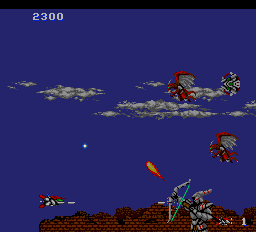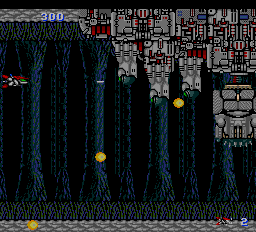Retro Replay Review
Gameplay
Heavy Unit delivers a classic side-scrolling shooter experience that feels both familiar and rewarding. Players pilot a specialized starship through six distinct levels, each teeming with waves of alien attackers, environmental hazards, and challenging mid-level and end-level bosses. The responsive controls make dodging enemy fire and navigating tight corridors feel smooth, while the constant influx of foes keeps the adrenaline pumping from start to finish.
A key feature of Heavy Unit is its upgrade system. Defeated enemies drop power-ups that boost your ship’s speed, weapon strength, shield capacity, or grant extra lives. The true highlight is the transformation into a powerful robot form, trading your small profile for devastating lasers and homing energy balls. This risk-reward mechanic forces you to weigh the benefits of superior firepower against the increased hitbox, adding a strategic layer to the frantic shooting.
Despite its straightforward premise, the game maintains variety through level design and enemy placement. Each stage introduces unique formations, moving obstacles, and unpredictable boss patterns, ensuring that no two encounters feel identical. Checkpoints are generously placed, but the difficulty ramps up quickly, pushing players to master enemy patterns and power-up management. Whether you stick to the nimble starship or embrace the raw strength of the robot, every run through Le Tau’s defenses feels satisfying.
Graphics
Visually, Heavy Unit adheres to the 16-bit aesthetic of its era, showcasing colorful, detailed sprites and layered backgrounds. The human colony of Le Tau appears in stark contrast to the alien worlds beyond, with mechanical platforms, rocky caverns, and eerie extraterrestrial architecture rendered in crisp pixel art. Enemy designs range from swarming drones to colossal boss machines, each animated with fluid attack sequences and explosive demise effects.
The Sega Genesis version stands out with a broader color palette and larger enemy sprites, lending battles a more imposing feel. Parallax scrolling adds depth to each stage, as distant mountains or starfields drift at different speeds behind the foreground action. Minor variations in enemy placement and palette swaps keep the visual experience fresh across multiple playthroughs, encouraging players to revisit levels and discover subtle changes.
Attention to detail extends to the on-screen explosions and particle effects, which pop against darker backgrounds without overwhelming the action. The robot transformation sequence is accompanied by distinct visual cues, such as a glowing energy field and an expanded sprite size, making power-up collection instantly gratifying. Overall, Heavy Unit’s graphics strike a fine balance between clarity and spectacle, ensuring the chaos of combat remains readable even amidst screen-filling boss battles.
Story
The narrative of Heavy Unit is elegantly simple: the remote human colony Le Tau is under siege by a mysterious alien force, and you are the pilot entrusted with its defense. Though the story unfolds primarily through an introductory blurb and manual text, it provides just enough context to frame the relentless onslaught of enemies and the imperative to push deeper into alien territory.
There are no elaborate cutscenes or dialogue sequences; instead, the focus remains firmly on the action. This minimalistic approach suits the genre, allowing players to jump straight into the fray without distraction. Each level’s visual cues—crumbling fortifications, scorched landscapes, and alien architecture—tell a story of escalating desperation and the high stakes facing humanity.
While purists may crave a deeper narrative, Heavy Unit’s streamlined story complements its arcade-style gameplay. The lack of exposition keeps the pacing brisk, and every boss encounter feels like a climactic step toward repelling the invaders. In the end, the game’s storytelling is concise but effective, framing the violence without overshadowing the core shooter experience.
Overall Experience
Heavy Unit succeeds as a love letter to classic side-scrolling shooters, offering tight controls, varied level design, and a satisfying risk-reward upgrade system. The balance between the agile starship and the hulking robot form creates memorable gameplay moments, as players adapt their strategies on the fly to tackle overwhelming enemy waves and punishing boss encounters.
The visual and audio presentation enhances the sense of immersion without ever becoming distracting. Differences between versions—such as the Genesis port’s richer colors and bolder sprites—offer subtle incentives to explore multiple iterations, while the core action remains consistently engaging. Even seasoned shooter fans will find plenty of replay value in chasing high scores and mastering each level’s nuances.
Ultimately, Heavy Unit stands as a solid entry in the 16-bit shooter canon. Its straightforward premise, combined with thoughtful power-up mechanics and challenging encounters, make it a worthy addition to any retro gaming collection. Whether you’re drawn by nostalgia or seeking a robust arcade experience, Heavy Unit delivers an intense journey through hostile alien territory that’s hard to put down.
 Retro Replay Retro Replay gaming reviews, news, emulation, geek stuff and more!
Retro Replay Retro Replay gaming reviews, news, emulation, geek stuff and more!









Reviews
There are no reviews yet.